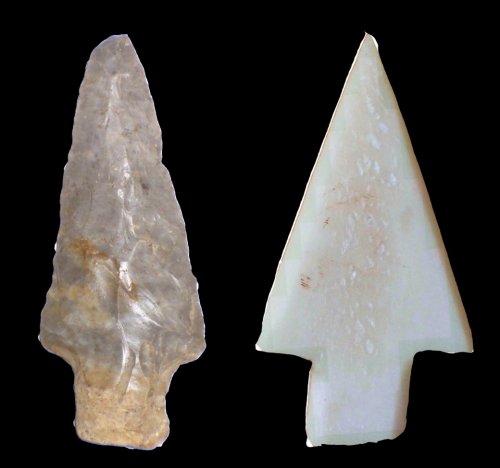

It doesn't look good for Kanti. Her deep wounds are now infected, and she's slipping into a coma. Mother is doing her best, but she can't reduce Kanti's fever. Early Americans didn't have antibiotics like we do today, and many people died from simple infections. Hopefully, that won't be Kanti's fate. You'll have to read farther if you want to find out what happens to her. I'm not tellin'. This whole mess resulted from Kanti betting her spear against Ahanu's bear-claw necklace. Makes you wonder what her spear looks like, doesn't it? As a reward for reading this far in the book, we will not only show you what her spear looks like, we will show you how to make your own spear.
Projectile Points

The most important part of a spear is the sharp tip. Some spear tips were made of stone like the projectile point on the left side of the picture. You may want to call this an arrowhead, but since we don't know if it was strapped to an arrow or a spear, most archeologists would call it a projectile point. An Adena Indian made this projectile point thousands of years ago using a process called flint knapping. The process is too complex to explain at this time. (Perhaps in the next Chogan book.) Grandfather made Kanti's spear tip from bone similar to the projectile point on the right. Bone spear tips were common, but unlike stone artifacts they deteriorate over time, so few are preserved. Flat bones such as shoulder blades from large animals make the best projectile points. Early Native Americans shaped the bones into projectile points or knife blades by rubbing the bone against abrasive stones. They obtained very sharp points and cutting edges with this method. Whether it be stone or bone, each projectile point needed a stem to connect it to the spear or arrow.
Binding Materials
A sharp tip is worthless unless it can be rigidly attached to the shaft of the spear. The usual binding materials stretch and can’t adequately secure the projectile point to the shaft. For this task early Americans relied on sinew from wild game. Sinew includes connective tissues such as tendons, ligaments, and fascia. The picture at the right shows a slab of pork tenderloin purchased at a local grocery store. The white cord is a tendon that attaches the muscle to the bone. Tendons have to be tough to withstand the strong pull from the muscle. They are also soft and pliable when moist—perfect for attaching spear heads to shafts.
Binding Spearhead to Shaft
Preparing the shaft is not a simple task. First a straight, slender pole has to be cut down using only stone tools. Then a notch must be carved into one end of the shaft to accept the projectile stem. At left the stem of the bone projectile point has been inserted into the shaft's notch and bound with a tendon from the pork tenderloin. Once dry, the tendon becomes hard and rigid. Unlike other binding material, it does not stretch. It also shrinks as it dries, turning the shaft's notch into a vise.
Spear with Eagle Feather
The spear at the right is what Kanti would like her spear to look like. All she lacks is Migizi's tail feather, and unless her arms grow much longer, obtaining an eagle feather does not look promising. If she doesn't survive her current illness, a feather for her spear is meaningless.
You are probably wondering why the eagle feather is so important. Native Americans believed eagle feathers were good luck charms like we would consider a rabbit's foot. It was also ornamental, and girls throughout history have always liked pretty things.
Before anyone goes out to pluck one of Migizi's tail feathers to add to their homemade spear, I should point out that possession of eagle feathers is illegal and punishable by fines up to $25,000 and imprisonment. The law makes an exception for Native Americans using them for religious ceremonies. Having legal Native American status will not protect you from fines; you will still need a special permit, which are difficult to obtain.
Since I can't afford a $25,000 fine, and I am too busy to do jail time, DNA testing of the above "eagle" feather will look similar to a commercial turkey feather purchased from Crazy Crow's Trading Post. I suggest you obtain your "eagle" feather from a similar outlet.
Enough about spears and $25,000 eagle feathers. Let's get back and see how Kanti is faring. Last I checked, it didn't look good.